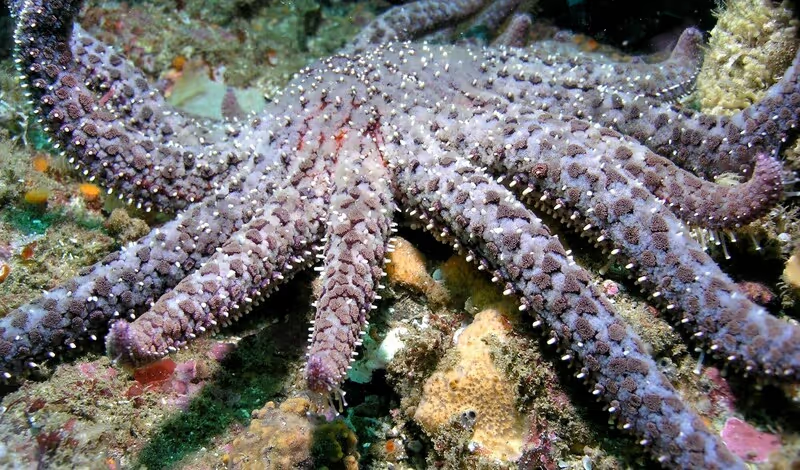Sunflower Sea Stars


Sunflower sea stars (Pycnopodia helianthoides) are the second largest sea star in the world, being able to grow up to 3.3 feet (1 m) in diameter. (The largest, in terms of diameter, is Midgardia xandaros [Downey 1972], a species native to the Gulf of Mexico and Honduras whose holotype has a radius of 680mm. This equates to a diameter of 53.5 inches [136cm].) They can be found along the Pacific Coast of North America from the Aleutian Islands to Baja California. They are typically found in the intertidal zone up to 400 feet (120 m), but may be found in depths up to 1,493 feet (455 m). However, their numbers have been substantially reduced in the southern part of their range from Washington to California and extant in Baja California due to the sea star wasting syndrome (SSWS) outbreak that began in 2013.

Sunflower sea stars can have 16 to 24 arms and weight up to 13.4 pounds (5 kg). They can have up to 15,000 tube feet, which help make sunflower sea stars the fastest-moving sea star in the world, capable of moving up to 5.2 feet (160 cm) per minute. They can be orange, pink, yellow, brown, or purple in color.
Sunflower sea stars mate from March to July through broadcast spawning. The larval stage lasts about ten weeks, during which the larvae live as free-swimming plankton. They then settle onto the bottom and metamorphose into a juvenile sea star. Juveniles start with five arms and grow more as they age. Their estimated lifespan is from 20-65 years.
A sunflower sea star’s diet typically consists of macroinvertebrates such as gastropods, bivalves, and crustaceans. They are predators, but may also forage the carrion of fish, squid, and seabirds. They especially prefer purple sea urchins (Strongylocentrotus purpuratus), which can make up 21 to 98 percent of a sunflower sea star’s diet depending on availability (Aquarium of the Pacific n.d.). Unlike most sea stars who eat by exerting their stomachs through their mouths, sunflower sea stars are capable of opening their mouth wide enough that they only need to exert their stomachs for larger prey.
As we’ve mentioned previously, sunflower sea stars were the most susceptible to the most recent outbreak of sea star wasting syndrome, which killed an estimated 99.2% of Washington’s total population. Thus far they have not been able to recover. In fact their numbers are continuing to decline. This is especially problematic given their role as a keystone species. One study found that the decrease in sunflower sea stars has led to a 311% increase in medium-sized sea urchins and 30% decline in kelp densities (Burt et al. 2018).
In 2020, the IUCN listed sunflower sea stars as critically endangered (Frierson et al.). However, this alone does not qualify the species for listing or protections under the U.S. Endangered Species Act. A petition to gain them these protections was submitted by the Center for Biological Diversity in 2021 (Sakashita 2021). The species is currently under review for ESA listing by the National Marine Fisheries Service and a decision will be made by August 2022 (Center for Biological Diversity 2021). In the meantime, the University of Washington, in partnership with the Nature Conservancy, have undertaken the first attempts to raise sunflower sea stars in a lab environment in an effort to aid their recovery (Ma and Taguchi 2021).
Edited August 27, 2022.
References
Aquarium of the Pacific. (n.d.). Sunflower sea star. Sunflower Sea Star | Online Learning Center | Aquarium of the Pacific. Retrieved May 30, 2022, from https://www.aquariumofpacific.org/onlinelearningcenter/species/sunflower_sea_star
Burt, J. M., Tim Tinker, M., Okamoto, D. K., Demes, K. W., Holmes, K., & Salomon, A. K. (2018). Sudden collapse of a mesopredator reveals its complementary role in mediating rocky reef regime shifts. Proceedings of the Royal Society B: Biological Sciences, 285(1883). https://doi.org/10.1098/rspb.2018.0553
Downey, M. E. (1972). Midgardia xandaros new genus, new species, a large brisingid starfish from the Gulf of Mexico. Proceedings of the Biological Society in Washington, 84(48), 421–426. Retrieved August 27, 2022, from https://www.biodiversitylibrary.org/page/34563503.
Frierson , T., Gehman , A., Alvstad , K., Saccomanno, V., Heady, W., Hamilton , S., & Gravem , S. (2020, August 26). The IUCN Red List of Threatened Species. IUCN Red List of Threatened Species. Retrieved May 24, 2022, from https://www.iucnredlist.org/species/178290276/197818455
Ma, M., & Taguchi, K. (2021, April 27). Thousands of baby sea stars born at UW Lab are sign of hope for Endangered Species. UW News. Retrieved May 25, 2022, from https://www.washington.edu/news/2021/04/27/thousands-of-baby-sea-stars-born-at-uw-lab-are-sign-of-hope-for-endangered-species/
NOAA Fisheries (2022) NOAA Fisheries Weighs Protection for Sunflower Sea Star Native to West Coast NOAA. Retrieved May 24, 2022, from https://www.fisheries.noaa.gov/feature-story/noaa-fisheries-weighs-protection-sunflower-sea-star-native-west-coast
Sakashita, M. (2021). Petition to List Sunflower Sea Star as Threatened or Endangered Under the U.S. Endangered Species Act. Center for Biological Diversity. Retrieved May 24, 2022, from https://www.biologicaldiversity.org/species/invertebrates/pdfs/2021-08-18-Petition-sunflower-sea-star.pdf.
Sunflower Sea Star One Step Closer to Endangered Species Act Protection. (2021, December 27). Center for Biological Diversity. Retrieved May 26, 2022, from https://biologicaldiversity.org/w/news/press-releases/sunflower-sea-star-one-step-closer-to-endangered-species-act-protection-2021-12-27/.
© Laura Caldwell, May 2022
Touch whale bones, examine shipwreck artifacts and connect with the coast's living history.

Support our mission, get involved in educational programs, or contribute through donations and volunteering.